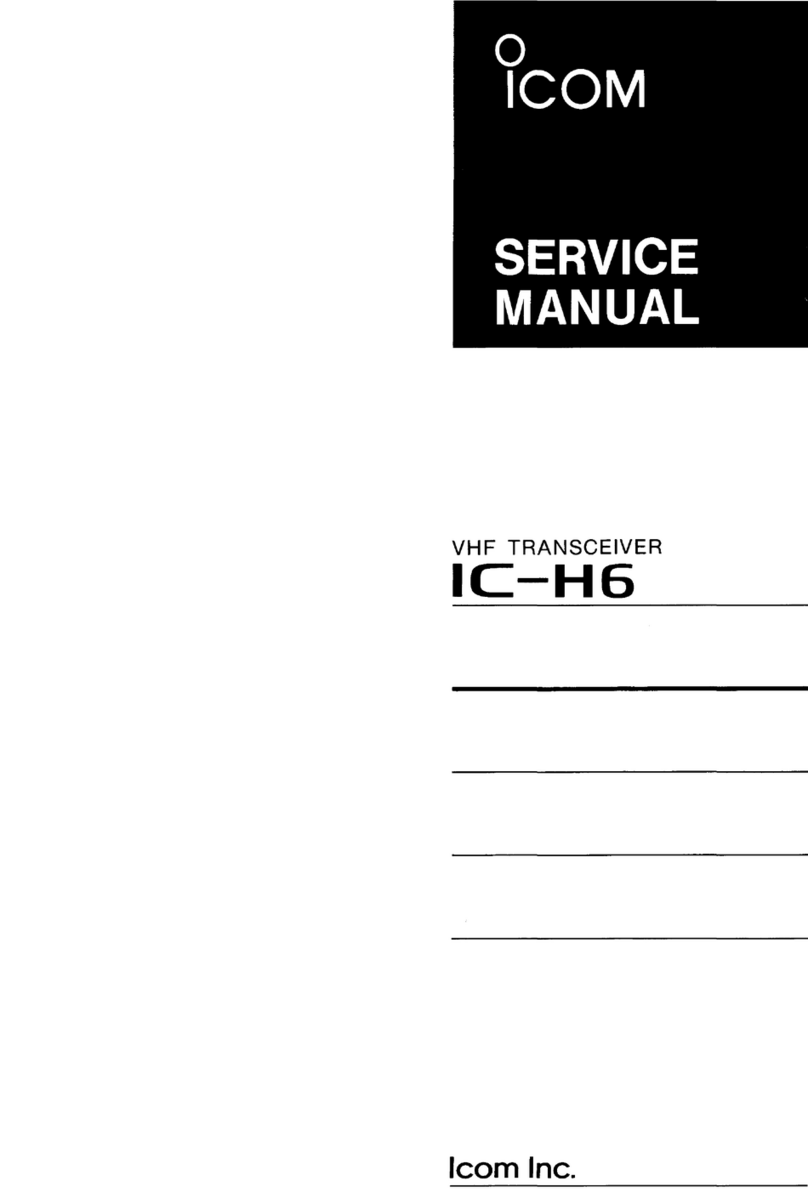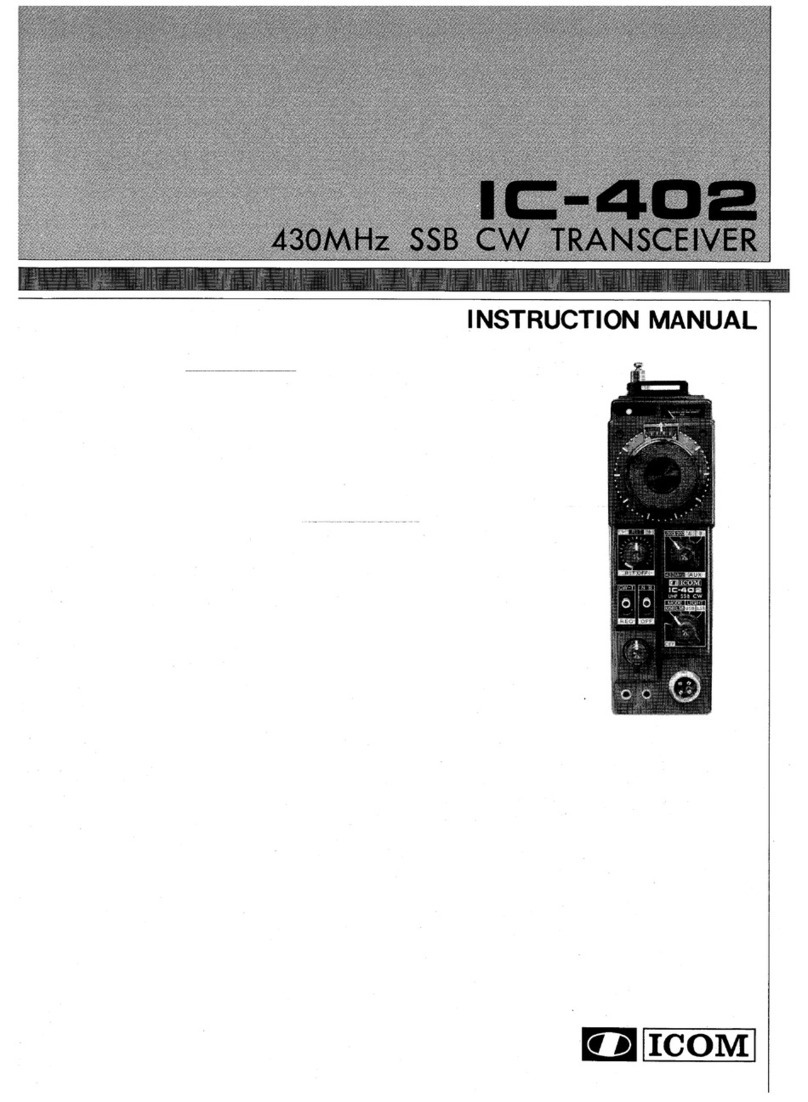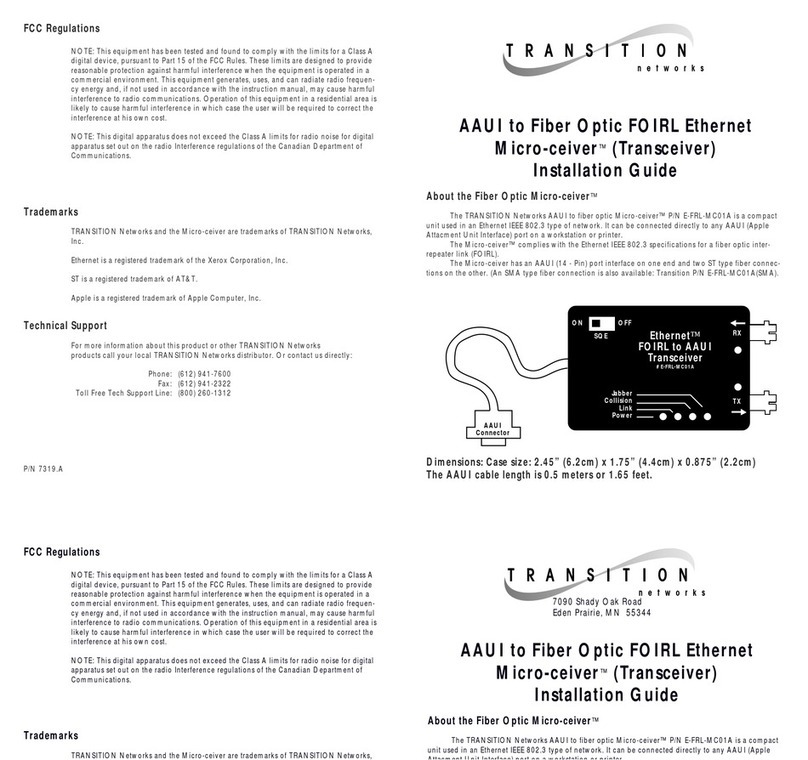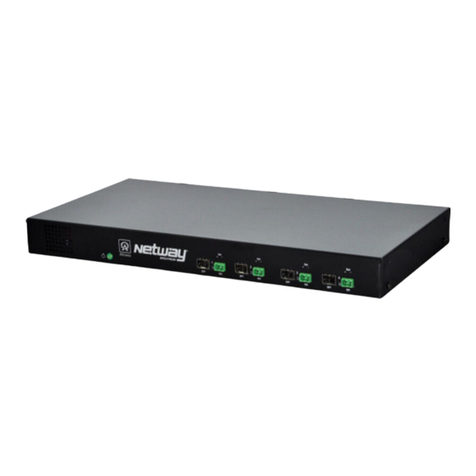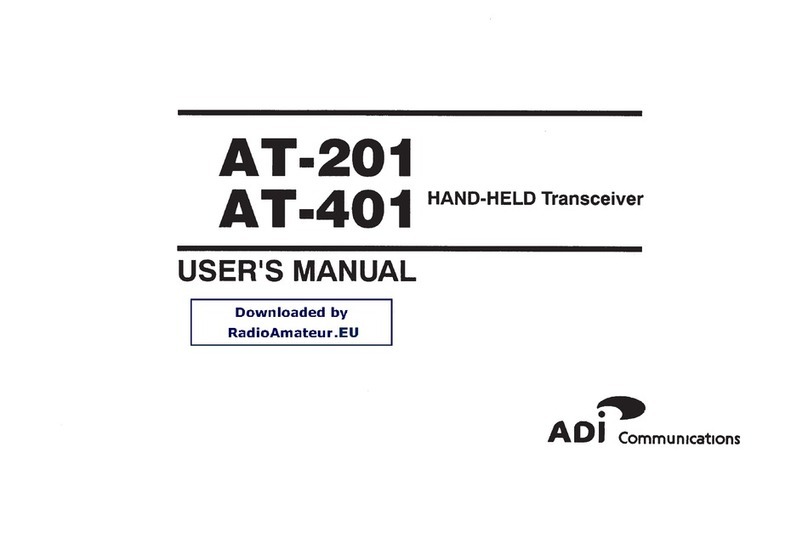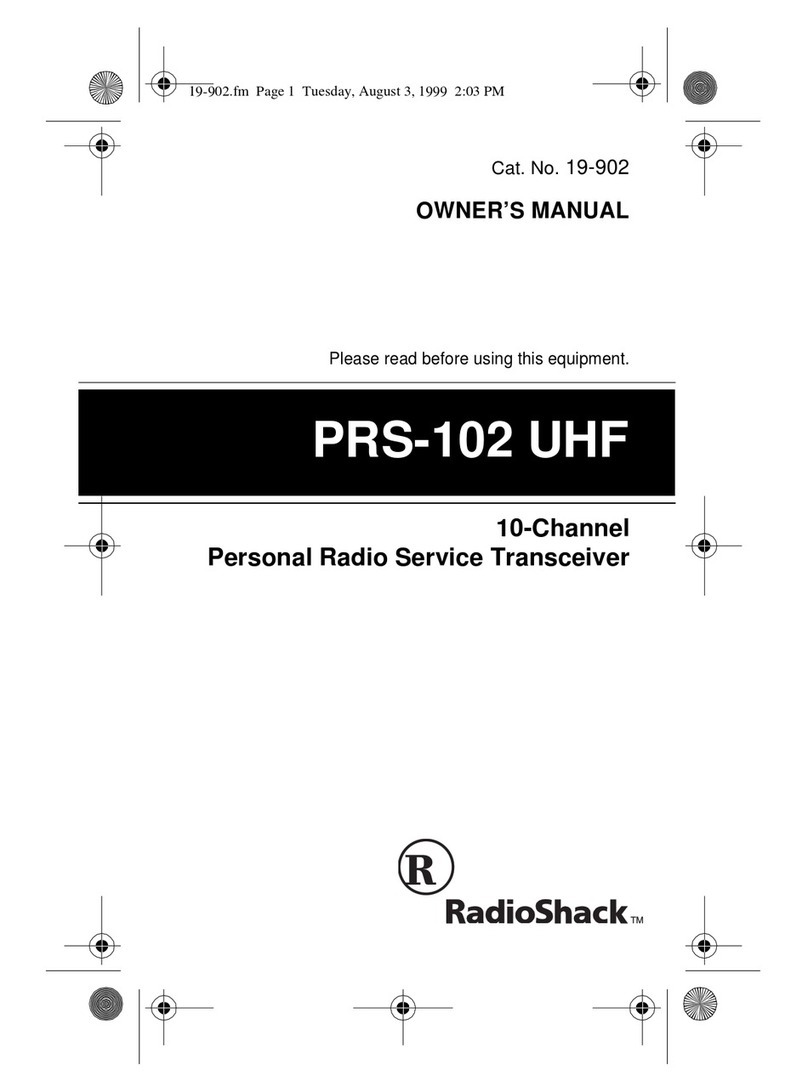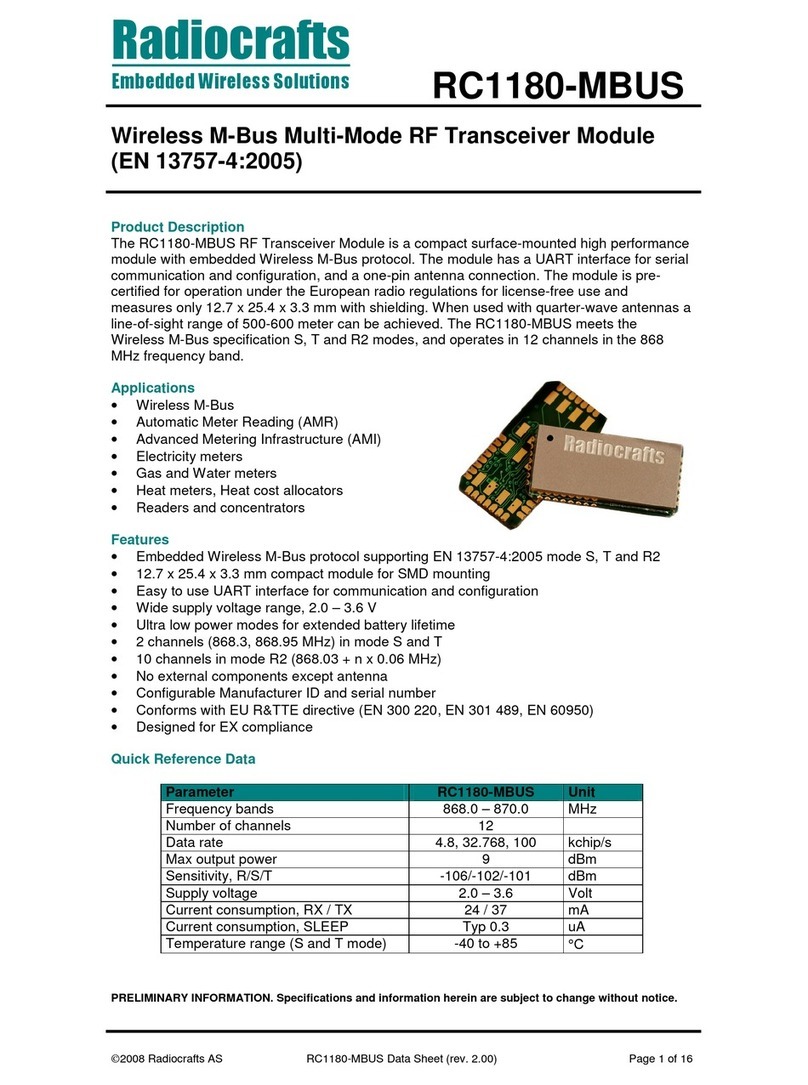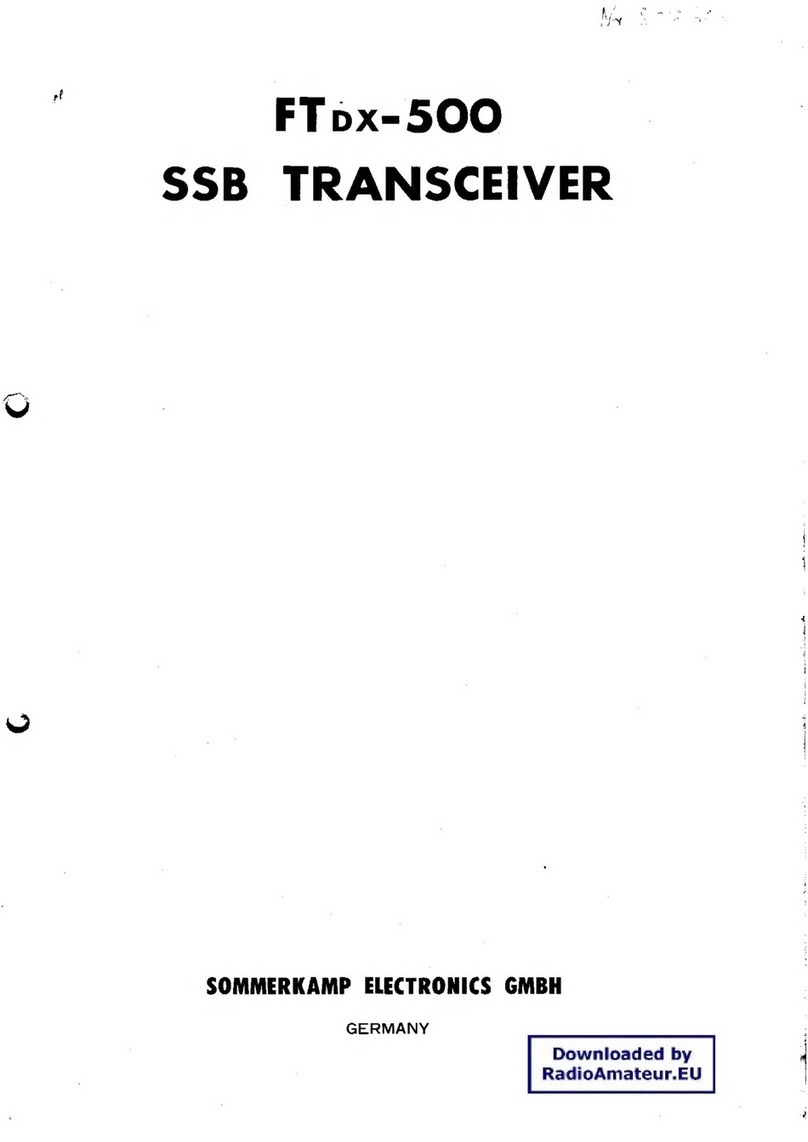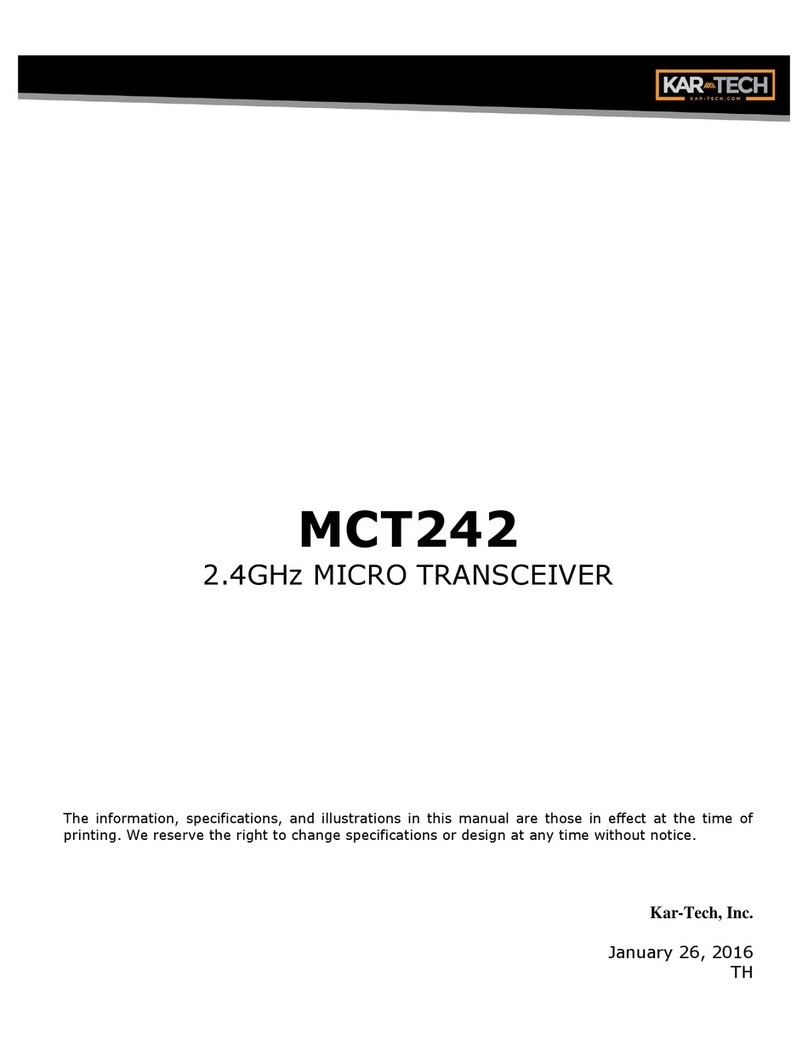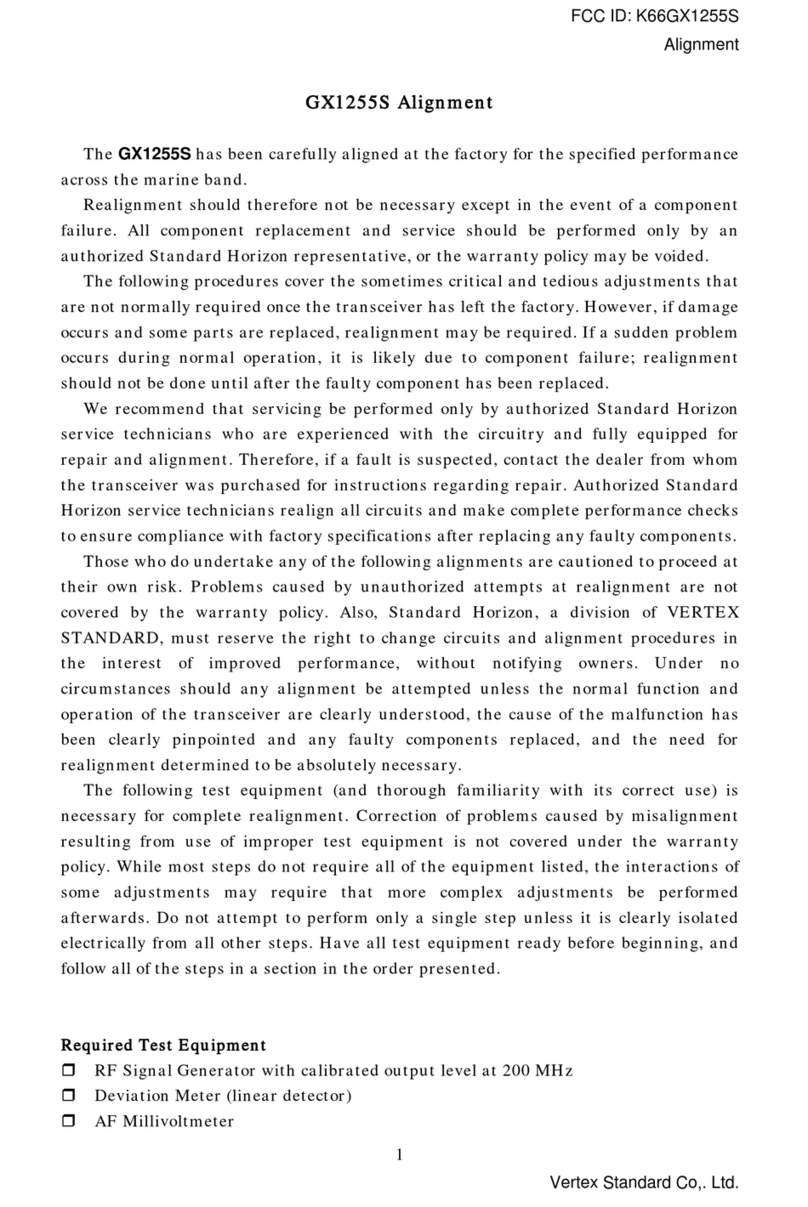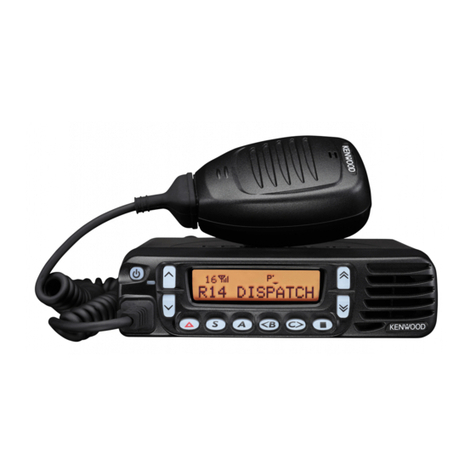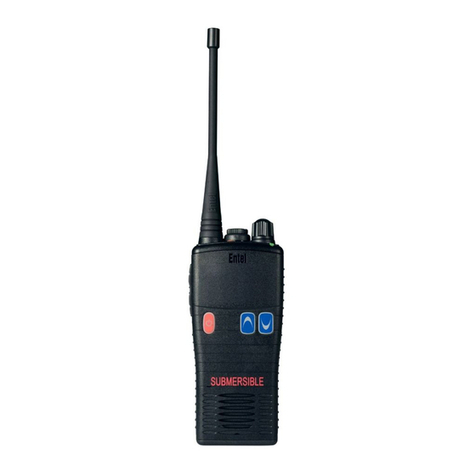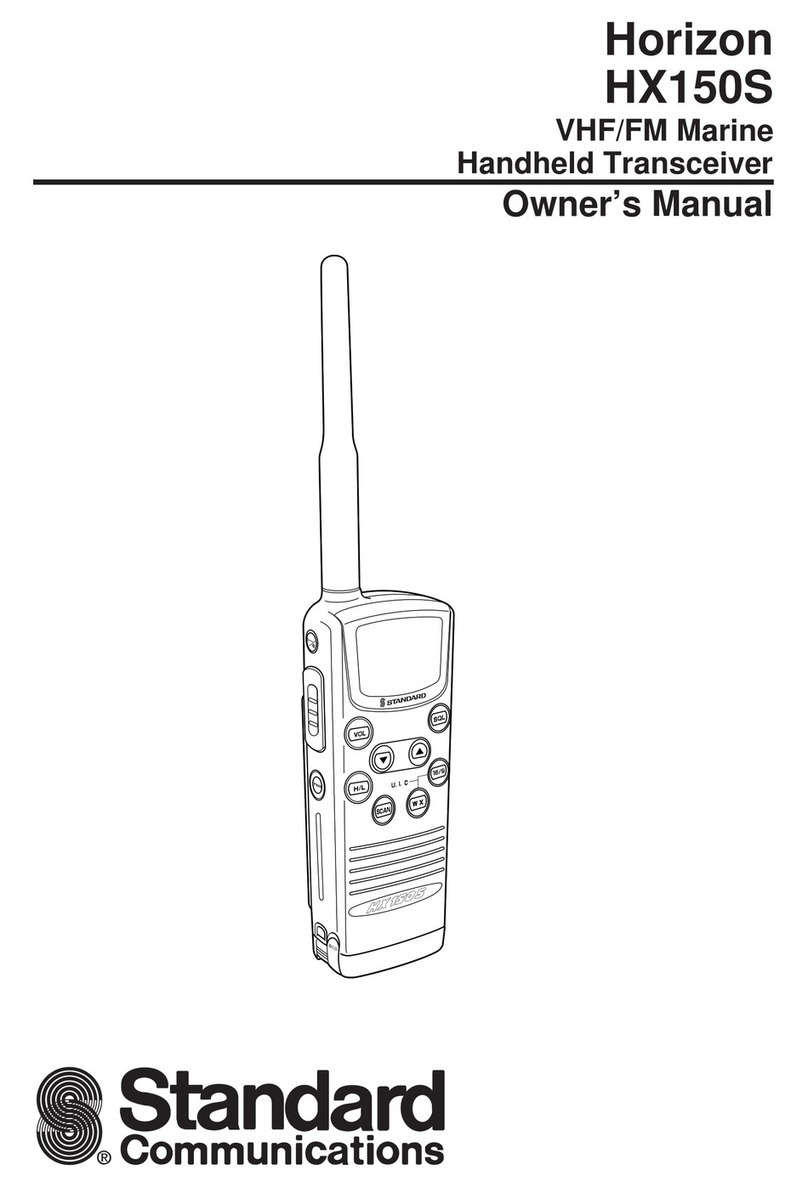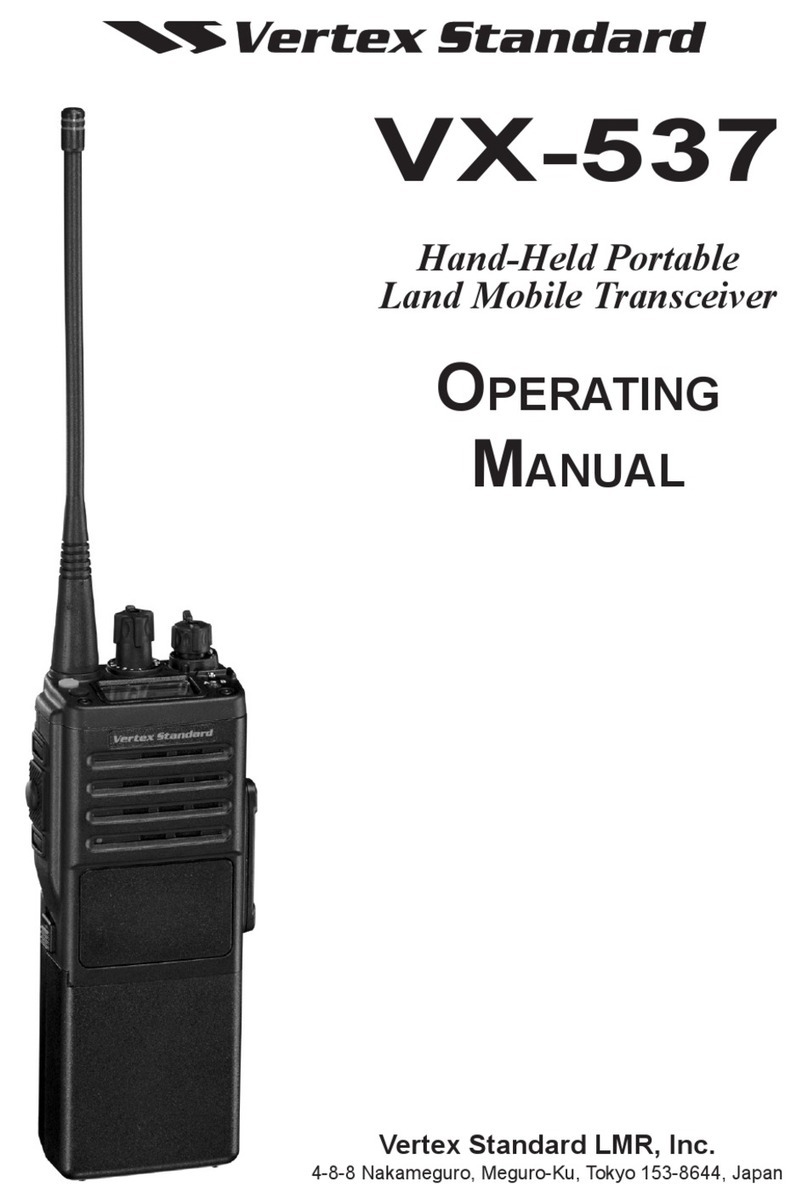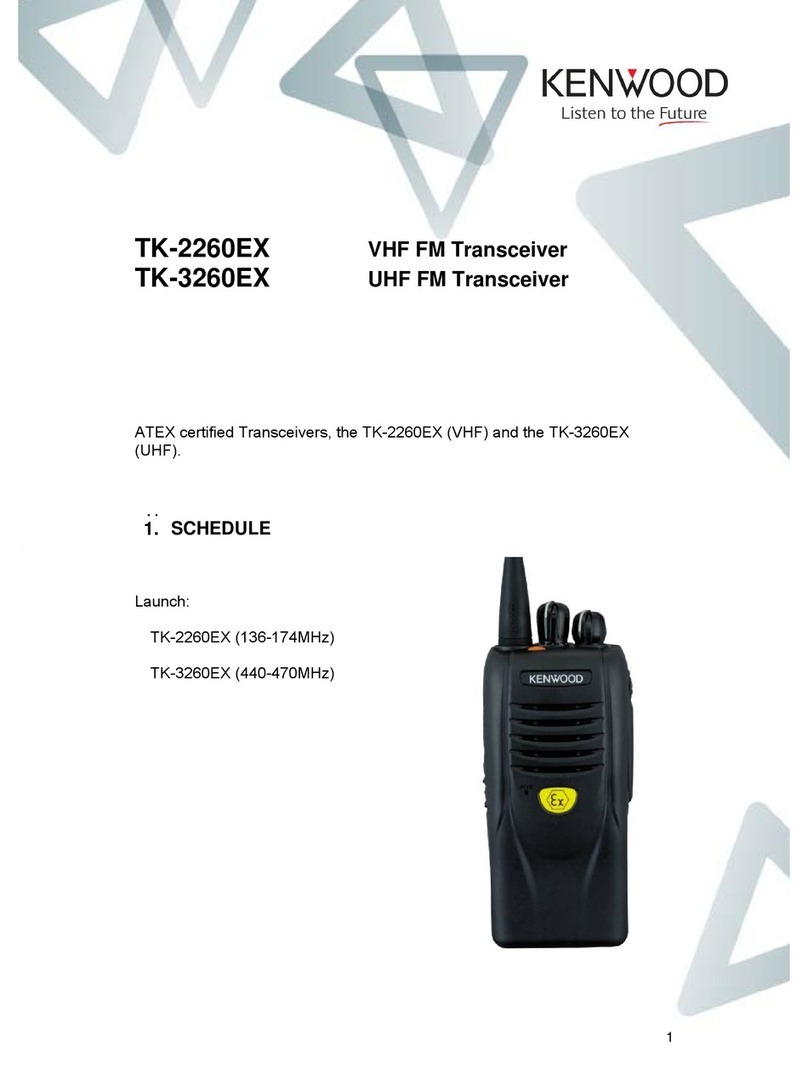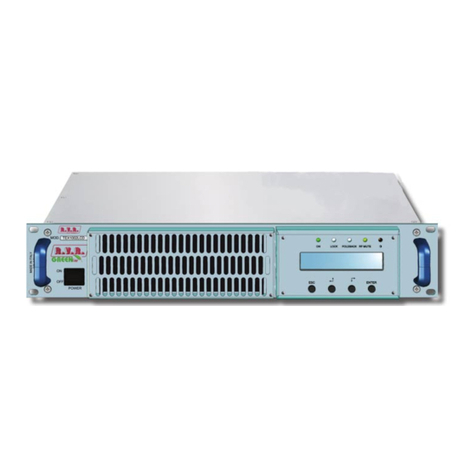Icom IC-F3162DT User manual

INSTRUCTION MANUAL
The photo shows the 10-key
version UHF transceiver.
UHF dPMR HANDHELD TRANSCEIVER
iF4162DT
iF4162DS
VHF dPMR HANDHELD TRANSCEIVER
iF3162DT
iF3162DS

i
IMPORTANT
READ ALL INSTRUCTIONS carefully and com-
pletely before using the transceiver.
SAVE THIS INSTRUCTION MANUAL — This
instruction manual contains important operating instruc-
tions for the IC-F3162DT/DS VHF dPMR HANDHELD
TRANSCEIVERS, IC-F4162DT/DS UHF dPMR HANDHELD
TRANSCEIVERS.
• This instruction manual includes some functions which
are usable only when they are pre-programmed by your
dealer. Ask your dealer for details.
• See the operating guide for details of BIIS (Binary Inter-
change of Information and Signaling) and dPMR (dig-
ital Private Mobile Radio) system operations. Ask your
dealer for details.
EXPLICIT DEFENITIONS
WORD DEFINITION
RDANGER! Personal death, serious injury or an explo-
sion may occur.
RWARNING! Personal injury, fire hazard or electric
shock may occur.
CAUTION Equipment damage may occur.
NOTE
If disregarded, inconvenience only. No risk
of personal injury, fire or electric shock.
Icom, Icom Inc. and the Icom logo are registered trademarks of Icom Incor-
porated (Japan) in Japan, the United States, the United Kingdom, Germany,
France, Spain, Russia and/or other countries.
All other products or brands are registered trademarks or trademarks of their
respective holders.

ii
1
2
3
4
5
6
7
8
9
10
11
12
13
14
15
16
RDANGER! NEVER short the terminals of the bat-
tery pack.
RWARNING! NEVER hold the transceiver so that
the antenna is very close to, or touching exposed parts of
the body, especially the face or eyes, while transmitting. The
transceiver will perform best if the microphone is 5 to 10 cm
away from the lips and the transceiver is vertical.
RWARNING! NEVER operate the transceiver with a
headset or other audio accessories at high volume levels.
CAUTION: NEVER use non-Icom battery packs/charg-
ers to prevent the loss of the transceiver’s good performance
and warranty.
DO NOT push [PTT] when not actually desiring to transmit.
DO NOT use or place the transceiver in direct sunlight or in
areas with temperatures below –25°C or above +55°C.
The basic operations, transmission and reception of the
transceiver are guaranteed within the specified operating
temperature range. However, the LCD display may not oper-
ate correctly, or show an indication in the case of long hours
of operation, or after being placed in extremely cold areas.
DO NOT modify the transceiver. The transceiver warranty
does not cover any problems caused by unauthorized modi-
fication.
KEEP the transceiver away from the heavy rain, and never
immerse it in the water. The transceiver meets IP55* require-
ments for dust-protection and water jet resistance.
However, once the transceiver has been dropped, dust-pro-
tection and water jet resistance cannot be guaranteed due
to the fact that the transceiver may be cracked, or the water-
proof seal damaged, etc.
* Only when the supplied battery pack, flexible antenna and connec-
tor cover are attached.
PRECAUTIONS

iii
VOICE CODING TECHNOLOGY
The AMBE+2™ voice coding Technology embodied in this
product is protected by intellectual property rights including
patent rights, copyrights and trade secrets of Digital Voice
Systems, Inc. This voice coding Technology is licensed sole-
ly for use within this Communications Equipment. The user
of this Technology is explicitly prohibited from attempting to
extract, remove, decompile, reverse engineer, or disassem-
ble the Object Code, or in any other way convert the Object
Code into a human-readable form. U.S. Patent Nos.
#5,870,405, #5,826,222, #5,754,974, #5,701,390,
#5,715,365, #5,649,050, #5,630,011, #5,581,656,
#5,517,511, #5,491,772, #5,247,579, #5,226,084 and
#5,195,166.

iv
TABLE OF CONTENTS
IMPORTANT .......................................................................... i
EXPLICIT DEFENITIONS ..................................................... i
PRECAUTIONS.................................................................... ii
VOICE CODING TECHNOLOGY ........................................ iii
TABLE OF CONTENTS....................................................... iv
1 ACCESSORIES ...........................................................1–3
■ Supplied accessories ...................................................1
■ Accessory attachments ................................................1
2 PANEL DESCRIPTION..............................................4–10
■ Front panel ...................................................................4
■ Function display ...........................................................5
■ Programmable function keys........................................7
3 BASIC OPERATION................................................11–18
■ Turning power ON ......................................................11
■ Channel selection.......................................................12
■ Call procedure............................................................13
■ Receiving and transmitting.........................................13
■ User Set mode ...........................................................16
■ Scrambler function .....................................................16
■ Stun function ..............................................................16
■ Emergency transmission............................................17
■ Man Down Emergency Call........................................17
■ Automatic Key Lock function ......................................18
■ Priority A channel selection........................................18
■ Forced Narrow function ..............................................18
4 BATTERY CHARGING ............................................19–23
■ Caution.......................................................................19
■ Optional battery chargers...........................................21
5 BATTERY CASE............................................................24
■ Optional battery case (BP-240)..................................24
6 SWIVEL BELT CLIP ................................................25–26
■ MB-93 contents ..........................................................25
■ To attach.....................................................................25
■ To detach....................................................................26
7 SPEAKER MICROPHONE............................................27
■ Optional HM-169/HM-170GP description...................27
■ To attach.....................................................................27
8 OPTIONS.................................................................28–32
■ About VS-1SC v o x /p t t c a s e ......................................31
9 DOC .........................................................................33–34
1
2
3
4
5
6
7
8
9
10
11
12
13
14
15
16

1
1ACCESSORIES
■Supplied accessories
The following accessories are supplied.
Battery pack Belt clip
Connector cover
(with screw)
Flexible antenna
(This illustration is
for the UHF type.)
■Accessory attachments
DFlexible antenna
Connect the supplied flexible antenna
to the antenna connector.
CAUTION:
• NEVER carry the transceiver by
holding only the antenna.
• DO NOT connect the anntena
other than listed on page 29.
• Transmitting without an antenna
may damage the transceiver.

2
1
ACCESSORIES
1
2
3
4
5
6
7
8
9
10
11
12
13
14
15
16
DBattery pack
To attach the battery pack:
Slide the battery pack on the back of the transceiver in the direc-
tion of the arrow (q), then lock it with the battery release button.
• Slide the battery pack until the battery release button makes a
‘click’ sound.
To remove the battery pack:
Slide the battery release button in the direction of the arrow
(w) as shown below. The battery pack can be removed.
NEVER remove or attach the battery pack when the
transceiver is wet or soiled. This may result water or dust
getting into the transceiver/battery pack and may result in
the transceiver being damaged.
q
w
Battery release
button
Battery pack
NOTE: Keep the battery pack terminals clean. It’s a good
idea to clean the battery pack terminals once a week.
DBelt clip
To attach the belt clip:
qRemove the battery pack if it is attached.
wSlide the belt clip in the direction of the arrow, until the
belt clip is locked and makes a ‘click’ sound.
To remove the belt clip:
qRemove the battery pack if it is attached.
w Pinch the clip (q), and slide the belt clip in the direction
of the arrow (w).
q
w

3
1ACCESSORIES
DConnector cover
Attach the connector cover when optional equipment is not
used.
To attach the connector cover:
qAttach the connector cover over the multi-connector.
wTighten the screw.
q
w
Multi-
connector
Connector
cover
CAUTION:
When optional equipment is not in use, attach the con-
nector cover. Otherwise the terminals of the multi-connec-
tor may be shorted by a metal object, or become rusty by
water intrusion. This could damage the transceiver.
To detach the connector cover:
qRemove the screw using a phillips screwdriver.
wDetach the connector cover for the optional equipment
connector.
q
w

4
2
PANEL DESCRIPTION
1
2
3
4
5
6
7
8
9
10
11
12
13
14
15
16
■Front panel
w
e
t
r
y
q
!0
o
!1
u
i
Microphone
Speaker
Function display (p. 5)
qROTARY SELECTOR
Rotate to select the preprogrammed memory channels or
the operating zone. (Depending on the pre-programmed
settings.)
• Depending on the pre-programmed settings, selecting channel 1
using the rotary selector starts a scan. (Rotary Selector Home
function)
wANTENNA CONNECTOR
Connects the supplied antenna. (p. 1)
eDEALER-PROGRAMMABLE KEY [EMR]
Required functions can be programmed by your dealer.
(p. 6)
rDEALER-PROGRAMMABLE KEY [Side1]
Required functions can be programmed by your dealer.
(p. 6)
tPTT SWITCH [PTT]
Hold down to transmit; release to receive.
yDEALER-PROGRAMMABLE KEYS [Side2]/[Side3]
Required functions can be programmed independently by
your dealer. (p. 6)
u10-KEYPAD (Depending on versions.)
The keypad allows you to enter digits to;
• Select memory channels.
• Select TX code channels.
• Select DTMF codes (during transmit).
• Set TX codes.
• Input the password.
iDEALER-PROGRAMMABLE KEYS [P0] to [P3]
Required functions can be programmed independently by
your dealer. (p. 6)

oMULTI-CONNECTOR
Connect an optional equipment.
Connector cover
NOTE: Attach the connec-
tor cover when optional
equipment is not used.
See page 3 for details.
!0 BUSY/TRANSMIT INDICATOR
➥Lights green while receiving a signal, or when the
squelch is open.
➥Lights red while transmitting.
!1 VOLUME CONTROL [VOL]
➥Rotate to turn the power ON or OFF.
➥Rotate to adjust the audio output level.
■Function display
SET
CALA TXCU
TXC
q t iuyrew
!0
!1
o
qSIGNAL STRENGTH ICON
Shows relative receive signal strength level.
wLOW POWER ICON
Appears when low output power is selected.
eAUDIBLE ICON
➥ Appears when the channel is in the ‘Audible’ (unmute)
mode.
➥Appears when a matching signal is received.
r COMPANDER ICON
Appears when the Compander function is activated.
t SCRAMBLER ICON
Appears when the Voice Scrambler function is activated.
5
2PANEL DESCRIPTION

6
2
PANEL DESCRIPTION
1
2
3
4
5
6
7
8
9
10
11
12
13
14
15
16
y BELL ICON
Appears or blinks when a matching signal is received, de-
pending on the pre-programmed settings.
u CALL CODE MEMORY ICON
Appears when the call code memory is selected.
i SCROLL ICON
Appears when an SDM (Short Data Message), including
more than 12 characters, is selected in the received mes-
sage selection mode.*1, 2
o BATTERY ICON
Appears or blinks when the battery power decreases to a
specified level.
Indication
Full Middle Charging
required No batteryBattery level
blinks when the battery is exhausted.
blinks when the battery is being over charged.
!0 ALPHANUMERIC DISPLAY
➥Displays an operating channel number, channel name,
User Set mode contents, DTMF code, etc.
➥Depending on the pre-programmed settings, characters
are displayed in 1 line or 2 lines on the LCD.
• In this instruction manual, the LCD illustration is described as
having characters displayed in 2 lines.
!1 KEY ICON
Shows the programmed function of the front panel keys
([P0], [P1], [P2] and [P3]).
*1 BIIS operation only
*2 dPMR operation only

7
2PANEL DESCRIPTION
■Programmable function keys
The following functions can be assigned to [EMR],[Side1],
[Side2], [Side3], [P0], [P1], [P2] and [P3] programmable
function keys.
Consult your Icom dealer or system operator for details con-
cerning your transceiver’s programming.
If the programmable function names are bracketed in the fol-
lowing explanations, the specific key is used to activate the
function, depends on the pre-programmed settings.
CHANNEL UP, CHANNEL DOWN “UP” “DOWN”
➥Push to select an operating channel. When [Rotary selec-
tor] selects “operating channel,” this key is not available.
➥As described in the following topics, after pushing a pro-
grammed key, push [CH Up] or [CH Down] to select an
option, setting, etc.
ZONE “ZONE”
Push this key, then push [CH Up] or [CH Down] to select
the desired zone. When [Rotary selector] selects “operating
zone,” this key operation is not available.
What is “zone”?— Certain channels are grouped together
and assigned to a zone, according to their intended use.
For example, ‘Staff A’ and ‘Staff B’ are assigned to a “Busi-
ness” zone, and ‘John’ and ‘Cindy’ are assigned to a “Pri-
vate” zone.
ZONE UP , ZONE DOWN “ZNUP” “ZNDN”
Push to select an operating zone. When [Rotary selector] se-
lects “operating zone,” this key is not available.
SCAN “SCAN”
➥Push to start or cancel a scanning operation.
• When a scan is started by the Power ON Scan, Automatic Scan
or Rotary Selector Home function, push this key to cancel the
scan. The cancelled scan resumes after the pre-programmed
time period.
➥
Hold down this key for 1 second to display the scan group,
then push [CH Up] or [CH Down] to select the desired one.
SCAN ADD/DEL (TAG) “SCAD”
➥Push to add the selected channel to, or delete it from, the
scan group.
1. Push to display the scan group, then push [CH Up] or
[CH Down] to select the desired one.
2. Push to add the channel to, or delete it from, the select-
ed scan group.
3. Hold down for 1 second to exit the scan group selection
mode.
➥While a scan is paused on a non-priority channel, push
this key to delete the selected channel from the scan
group.
Depending on the pre-programmed settings, the cleared
channel is added to the scan group again after the scan
is cancelled. (Nuisance Delete function)

8
2
PANEL DESCRIPTIONv
PRIORITY A, PRIORITY B “PRA” “PRB”
Push to select the Priority A or Priority B channel.
PRIORITY A (REWRITE),
PRIORITY B (REWRITE) “PRAR” “PRBR”
➥ Push to select the Priority A or Priority B channel.
➥Hold down for 1 second to assign the operating channel to
the Priority A or Priority B channel.
MONITOR, MONITOR (AUDIBLE) “MON”
➥ Push to turn the CTCSS (DTCS) or 2/5-tone squelch mute
ON or OFF.
• Only during LMR (Land Mobile Radio) operation, push to
open any squelch, or deactivate any mute functions.
• Only during PMR (Private Mobile Radio) operation, push
to activate one or two of the following functions on each
channel (Depending on the pre-programmed settings):
- Hold down to unmute the channel (‘Audible’ mode).
- Push to mute the channel (‘Inaudible’ mode).
- After the communication is finished, push to send a ‘reset code’
(5-tone) or a ‘Clear Down’ signal (BIIS).
NOTE: The ‘Audible’ (unmute) mode may automati-
cally return to the ‘Inaudible’ (mute) mode, after the
pre-programmed time period.
➥Depending on the pre-programmed settings, holding down
this key for 1 second cancels a scan.
MEMORY CHANNELS 1, 2, 3, 4 “CH1” “CH2” “CH3” “CH4”
Push to select memory channel 1, 2, 3 or 4.
LOCK “LOCK”
➥ Hold down this key until “LOCK ON” is displayed to elec-
tronically look all programmable keys except the following:
[PTT], [Call] (incl. Call A and Call B), [Moni], [Light], [Emergency],
[Surveillance], [Lone Worker] and [OPT 1/2/3].
➥ When the Key Lock function is ON, hold down this key
until “LOCK OFF” is displayed to turn it OFF.
TONE/COLOUR CODE CHANNEL SELECT “T SEL”
➥While in the analog mode, push to enter the continuous
tone selection mode. Then push [CH Up] or [CH Down] to
select the desired tone frequency/code setting. After se-
lecting, push this key again to store the setting.
➥While in the digital mode, push to enter the colour code
selection mode. Then push [CH Up] or [CH Down] to se-
lect the desired colour code. After selecting, push this key
again to store the setting.
➥ While in the mixed (digital and analog) mode, push to enter
the continuous tone selection mode. Then push [CH Up] or
[CH Down] to select the desired tone frequency/code set-
ting. After selecting, push this key to store the setting. After
that, the colour code selection screen appears. Push [CH
Up] or [CH Down] to select the desired colour code. After
selecting, push this key again to store the setting.
1
2
3
4
5
6
7
8
9
10
11
12
13
14
15
16

9
2PANEL DESCRIPTION
TALK AROUND “TA”
Push to turn the Talk Around function ON or OFF.
• The Talk Around function equalizes the transmit frequency to the
receive frequency for transceiver-to-transceiver communication.
WIDE/NARROW “W/N”
Push to switch the IF bandwidth between wide and narrow.
• The wide passband width is pre-programmed to either 25.0 or 20.0 kHz
by your dealer (PMR operation only).
DTMF AUTODIAL “DTMA”
Push to enter the DTMF channel selection mode, then push
[CH Up] or [CH Down] to select a desired DTMF channel.
After selecting, push again to transmit the selected DTMF
code.
RE-DIAL “DTMR”
Push to transmit the last-transmitted DTMF code.
• TX memories are cleared after turning the power OFF.
HIGH/LOW “H/L”
Push to select the transmit output power level temporarily or
permanently, depending on the pre-programmed settings.
• Ask your dealer for the output power level for each selection.
LIGHT “LIGT”
Push to turn the backlight ON for about 5 seconds, when the
Backlight function is set to “OFF” in the User Set mode.
CALL, CALL A, CALL B “CALL” “CALA” “CALB”
Push to transmit a 2/5-tone code or BIIS/dPMR call.
• Call transmission is necessary before calling another station,
depending on your signalling system.
• [Call A] and/or [Call B] may be available when your system employs
selective ‘Individual/Group’ calls. Ask your dealer which call is
assigned to each key.
EMERGENCY “EMR”
Hold down for the pre-programmed time period to enter the
emergency mode. After the pre-programmed time period, an
Emergency call is transmitted once, or repeatedly.* (p. 17)
• To exit the emergency mode, hold down this key for the pre-pro-
grammed time period again, before transmitting.
* Depending on the pre-programmed settings.
SURVEILLANCE “SURV”
Push to turn the Surveillance function ON or OFF.
When this function is turned ON, the beep does not sound
and the LCD backlight and BUSY/TRANSMIT indicator do
not light, even when a signal is received or a key is pushed.
TX CODE ENTER “TXCE”
Push to enter the TX code edit mode (5Tone) (p. 15) or the
ID code edit mode (BIIS, dPMR), and then set the desired TX
code or ID code.

10
2
PANEL DESCRIPTION
TX CODE CHANNEL SELECT “TXC”
➥ Push to enter the TX code channel selection mode (p. 14)
or the ID selection mode (BIIS, dPMR), and then push [CH
Up] or [CH Down] to select the desired channel or ID.
➥Hold down this key for 1 second to enter the TX code
edit mode (5Tone) (p. 15) or the ID code edit mode (BIIS,
dPMR), and then set the desired TX code or ID code.
TX CODE CHANNEL UP,
TX CODE CHANNEL DOWN “TXCU” “TXCD”
Push to select a TX code channel (p. 14) or the ID (BIIS,
dPMR).
ID-MEMORY SELECT “IDMS”
➥Recalls detected ID codes.
• Push this key, then push [CH Up] or [CH Down] to select the ID
code.
• Up to 5 IDs are memorized.
➥Hold down for 1 second to erase the selected ID.
SCRAMBLER “SCR”
Push to turn the Voice Scrambler function ON or OFF.
COMPANDER “COMP”
Push to turn the Compander function ON or OFF.
The Compander function reduces noise components from the
transmitted audio to provide clear communication.
LONE WORKER “LONE”
Push to turn the Lone Worker function ON or OFF.
• If the Lone Worker function is turned ON, and no operation occurs
during the pre-programmed time period, the Emergency function is
automatically turned ON.
USER SET MODE “SET”
➥Hold down for 1 second to enter the User Set mode.
• In the User Set mode, push this key to select an item that is ena-
bled by your dealer, and change the value or setting by pushing
[CH Up] or [CH Down].
➥Hold down for 1 second again to exit the User Set mode.
The User Set mode is also available using the Power ON
function. Refer to page 16.
OPT 1, OPT 2, OPT 3 “OP1” “OP2” “OP3”
Push to output the control signal to the option connector. Ask
your dealer for details.
OPT 1 MOMENTARY, OPT 2 MOMENTARY,
OPT 3 MOMENTARY “O1M” “O2M” “O3M”
Outputs the control signal to the option connector while hold-
ing down this key. Ask your dealer for details.
See the operating guide for details of BIIS and dPMR
system operations. Ask your dealer for details.
1
2
3
4
5
6
7
8
9
10
11
12
13
14
15
16

■Turning power ON
Prior to using the transceiver for the first time, the battery
pack must be fully charged for optimum life and operation.
(p. 19)
qRotate [VOL] to turn the power ON.
wIf the transceiver is programmed for a start up password,
input the digit codes as directed by your dealer.
• 10-keypad can be used for password input, depending on
versions.
• The keys in the table below can be used for password input.
• The transceiver detects numbers in the same block as identical.
Therefore “01234” and “56789” are the same.
KEY
NUMBER 0
5
4
9
3
8
2
7
1
6
(Side1)
P0P1P2P3
eWhen the “PASSWORD” indication does not clear after
inputting 6 digits, the input code number may be incorrect.
Turn the power OFF and start over, in that case.
DBattery type selection
The battery type must be selected, according to the attached
battery type, when tuning the transceiver ON.
➥While holding down [Emer] and [PTT], rotate [VOL] to
select the attached battery type.
• After an indication appears, release [Emer] and [PTT].
• “ DRY BATT” is displayed for about 3 seconds, then “Lo” (low
power indicator) appears, when the battery case operation is
selected.
• “LI-ION” is displayed for about 3 seconds, when the Lithium-ion
battery operation is selected.
This operation may not be available, depending on the
pre-programmed settings. Ask your dealer for details.
11
3BASIC OPERATION

12
3
BASIC OPERATION
■Channel selection
Several types of channel selections are available. Methods
may differ, according to your system set up.
NON-ZONE TYPE:
To select the desired operating channel:
• Push [CH Up] or [CH Down].
• Rotate [ROTARY SELECTOR].*
- Up to preprogrammed 16 channels can be selected.
• Push one of [MR-CH 1] to [MR-CH 4].
ZONE TYPE:
To select the desired zone:
• Push [Zone], then push [CH Up] or [CH Down].
• Push [Zone Up] or [Zone Down].
• Rotate [ROTARY SELECTOR].*
- Up to preprogrammed 16 zones can be selected.
* Depending on the pre-programmed settings.
When [Rotary selector] selects “Operating channel,” [CH Up] and
[CH Down] are not available.
When [Rotary selector] selects “Operating zone,” [Zone], [Zone
Up] and [Zone Down] are not available.
DVoting operation
The transceiver automatically starts scanning when a zone,
specified for the voting operation, is selected.
The voting scan detects the signal strength of the repeaters,
and automatically selects the strongest one.
AUTOMATIC SCAN TYPE:
Channel setting is not necessary for this type. When turning
the power ON, the transceiver automatically starts scanning.
Scanning stops when receiving a call.
1
2
3
4
5
6
7
8
9
10
11
12
13
14
15
16

■Call procedure
When your system employs tone signalling (excluding CTCSS
and DTCS), a call procedure may be necessary prior to voice
transmission. The tone signalling employed may be a selec-
tive calling system, which allows you to call specic station(s)
only, and prevent unwanted stations from contacting you.
qSelect the desired TX code channel according to your sys-
tem operator’s instructions.
• This may not be necessary, depending on the pre-programmed
settings.
• Refer to pages 14 and 15 for details.
w Push [Call] (assigned to one of the dealer programmable
keys).
eAfter transmitting, the remainder of your communication
can be carried out in the normal fashion.
Selective calling Non-selective calling
■Receiving and transmitting
CAUTION: Transmitting without an antenna may damage
the transceiver. See page 1 for accessory attachments.
Receiving:
qRotate [VOL] to turn the power ON.
w Push [CH Up] or [CH Down], or rotate [ROTARY SELEC-
TOR]* to select a channel, in sequence.
*Depending on the pre-programmed settings.
eWhen receiving a call, rotate [VOL] to adjust the audio out-
put level to a comfortable listening level.
NOTE: Depending on the pre-programmed settings, the
transceiver automatically transmits the microphone audio
for the pre-programmed time period when a matching sig-
nal is received.
Transmitting:
Wait for the channel to become clear to avoid interference.
qWhile holding down [PTT], speak into the microphone at
your normal voice level.
• When a tone signalling system is used, the call procedure de-
scribed to the left may be necessary.
wRelease [PTT] to return to receive.
IMPORTANT: To maximize the readability of your signal;
1. Pause briefly after pushing [PTT].
2. Hold the microphone 5 to 10 cm from your mouth, then
speak into the microphone at a normal voice level.
13
3BASIC OPERATION

14
3
BASIC OPERATION
DTransmitting notes
•Transmitinhibitfunction
The transceiver has several inhibit functions which restrict
transmission under the following conditions:
- The channel is in the ‘Inaudible’ mode (“ ” (Audible icon)
does not appear.)
- The channel is busy. However, depending on the pre-
programmed settings, you can transmit when a call is re-
ceived that includes an unmatching (or matching) CTCSS
(DTCS), colour code, or Individual or Talkgroup ID.
- The selected channel is a ‘receive only’ channel.
•Time-outtimer
If continuous transmission exceeds the pre-programmed
time-out timer limit, the transmission is cut off.
•Penaltytimer
After the transmission is cut off by the time-out timer, trans-
mission is further inhibited for the pre-programmed penalty
timer period.
DTX code channel selection
If the transceiver has a key assigned to TX Code CH Select,
the indication can be toggled between the operating channel
number (or name) and TX code channel number (or name).
When the TX code channel number (or name) is displayed,
[CH Up] or [CH Down] selects the TX code channel.
USING [TX CODE CH SELECT]:
qPush [TX Code CH Select]— a TX code channel number
(or name) appears.
wPush [CH Up] or [CH Down] to select the desired TX code
channel.
eAfter selecting, push [TX Code CH Select] to set.
• Return to the stand-by mode.
rPush [Call] to transmit the selected TX code.
USING [TX CODE CH UP]/[TX CODE CH DOWN]:
If the transceiver has a key assigned for TX Code CH Up or
TX Code CH Down, the programmed TX code channel can be
directly selected when pushed.
1
2
3
4
5
6
7
8
9
10
11
12
13
14
15
16

15
3BASIC OPERATION
DTX code edit (5-tone operation only)
If the transceiver has a key assigned to TX Code CH Select
or TX Code Enter, TX code contents can be edited within the
allowable digits.
USING [TX CODE CH SELECT]:
qPush [TX Code CH Select] to enter the TX code channel
selection mode.
• Select the desired channel before entering the TX code channel
selection mode, if necessary.
wHold down [TX Code CH Select] for 1 second to enter the
TX code edit mode.
• The digit to be edited blinks.
ePush [TX Code CH Select] to select the desired digit to be
edited.
rPush [CH Up] or [CH Down] to select the desired digit.
tPush [TX Code CH Select] to set. The digit to the right will
automatically blink.
yRepeat rand tto edit all allowable digits.
uAfter editing, push [TX Code CH Select] to set.
• Return to the stand-by mode.
iPush [Call] to transmit.
USING [TX CODE ENTER]:
qAfter pushing [TX Code CH Select], push [CH Up] or [CH
Down], or push [TX Code CH Up] or [TX Code CH Down]
to select the desired TX code channel.
wPush [TX Code Enter] to enter the TX code edit mode.
• The digit to be edited blinks.
ePush [TX Code Enter] to select the desired digit to be ed-
ited.
rPush [CH Up] or [CH Down] to select the desired digit.
tPush [TX Code Enter] to set. The digit to the right will au-
tomatically blink.
yRepeat rand tto edit all allowable digits.
uAfter editing, push [TX Code Enter] to set.
• Return to the stand-by mode.
iPush [Call] to transmit.
DDTMF transmission
If the transceiver has a key assigned for DTMF Autodial, the
automatic DTMF transmission function is available. Up to 8
DTMF channels are selectable.
qPush [DTMF Autodial]— a DTMF channel appears.
wPush [CH Up] or [CH Down] to select the desired DTMF
channel.
ePush [DTMF Autodial] to transmit the DTMF code.
Other manuals for IC-F3162DT
1
This manual suits for next models
3
Table of contents
Other Icom Transceiver manuals
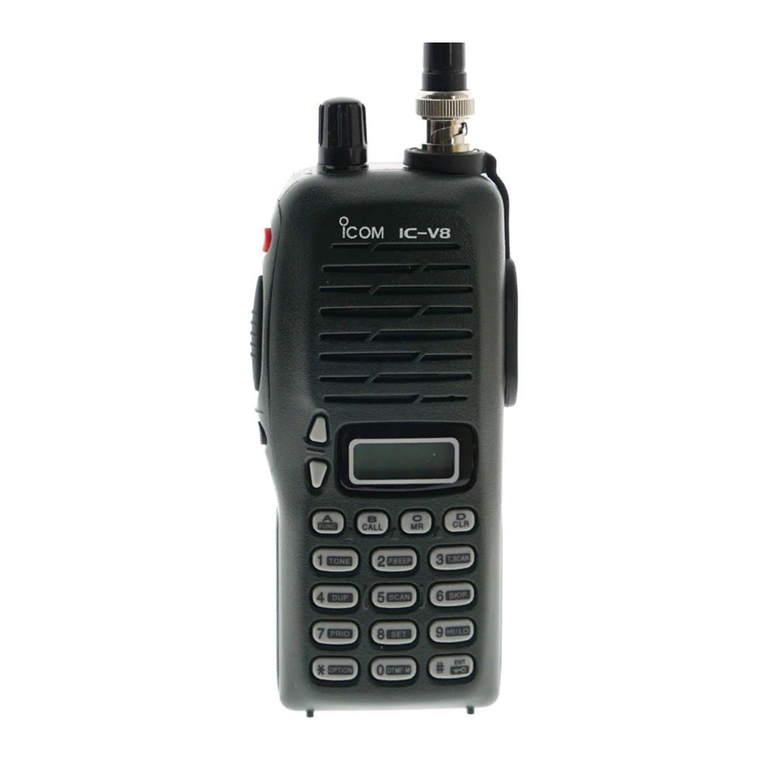
Icom
Icom IC-V8 User manual
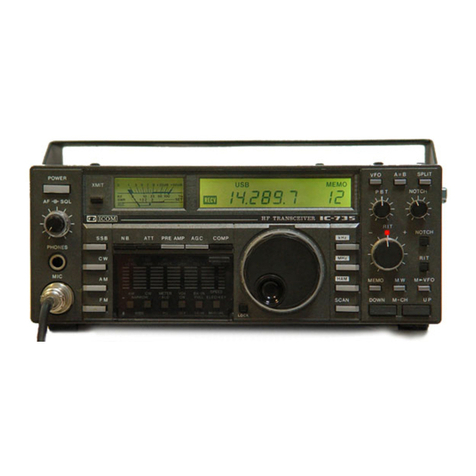
Icom
Icom IC-735 User manual
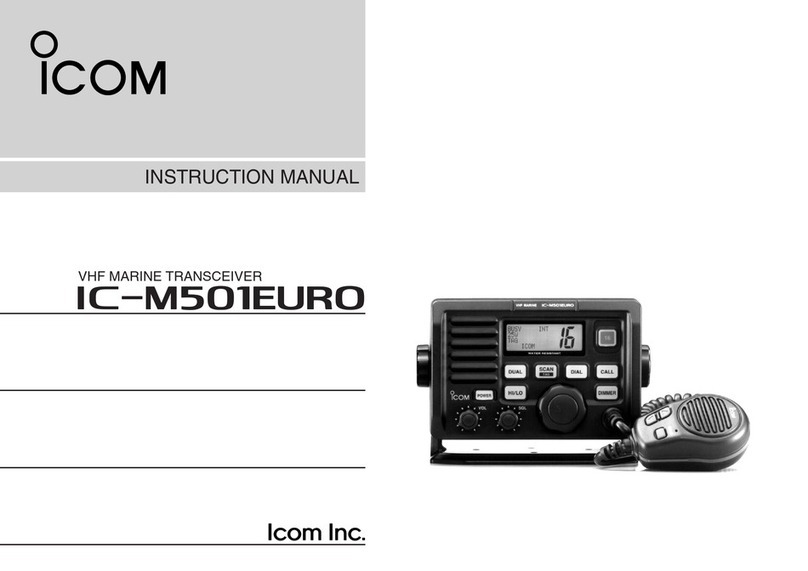
Icom
Icom VHF MARINE TRANSCEIVER IC-M501EURO User manual
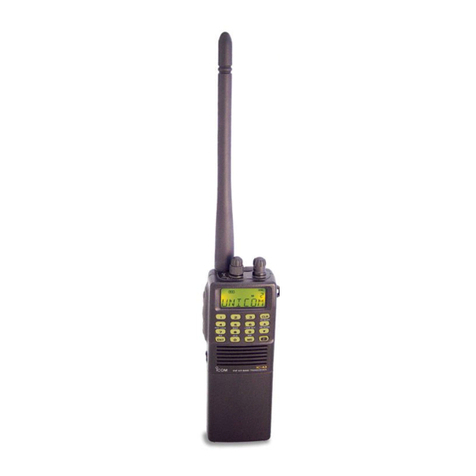
Icom
Icom IC-A3 User manual
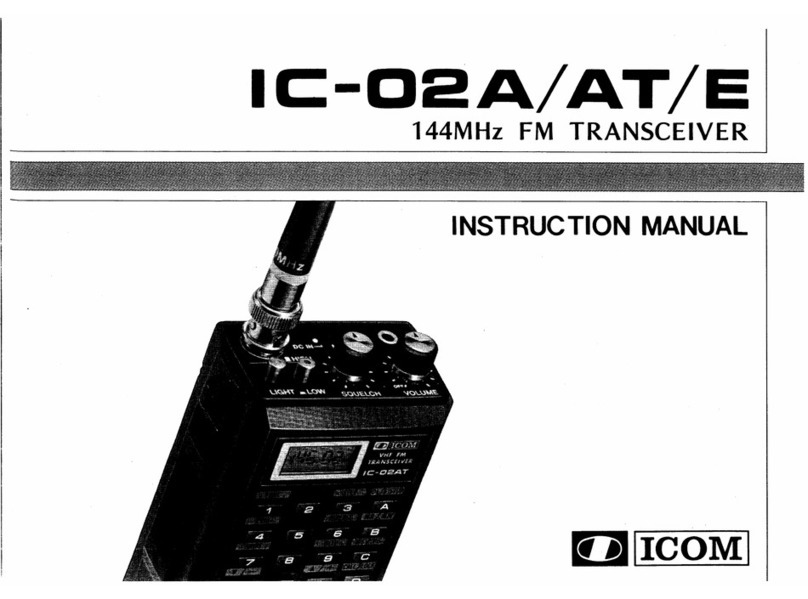
Icom
Icom IC-02A User manual
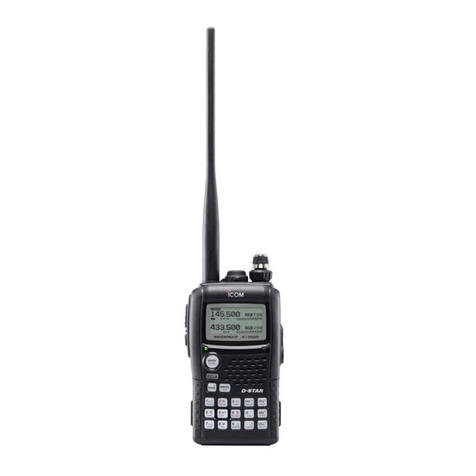
Icom
Icom IC-E92D User manual
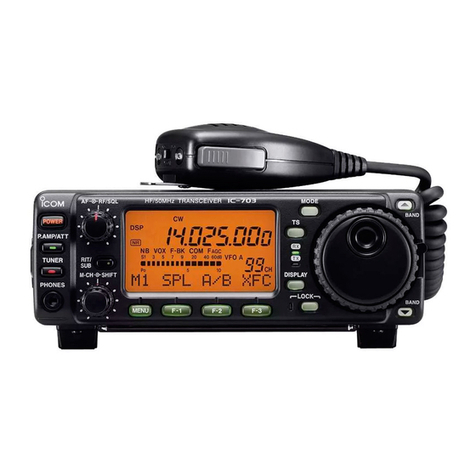
Icom
Icom IC-703 Instruction Manual
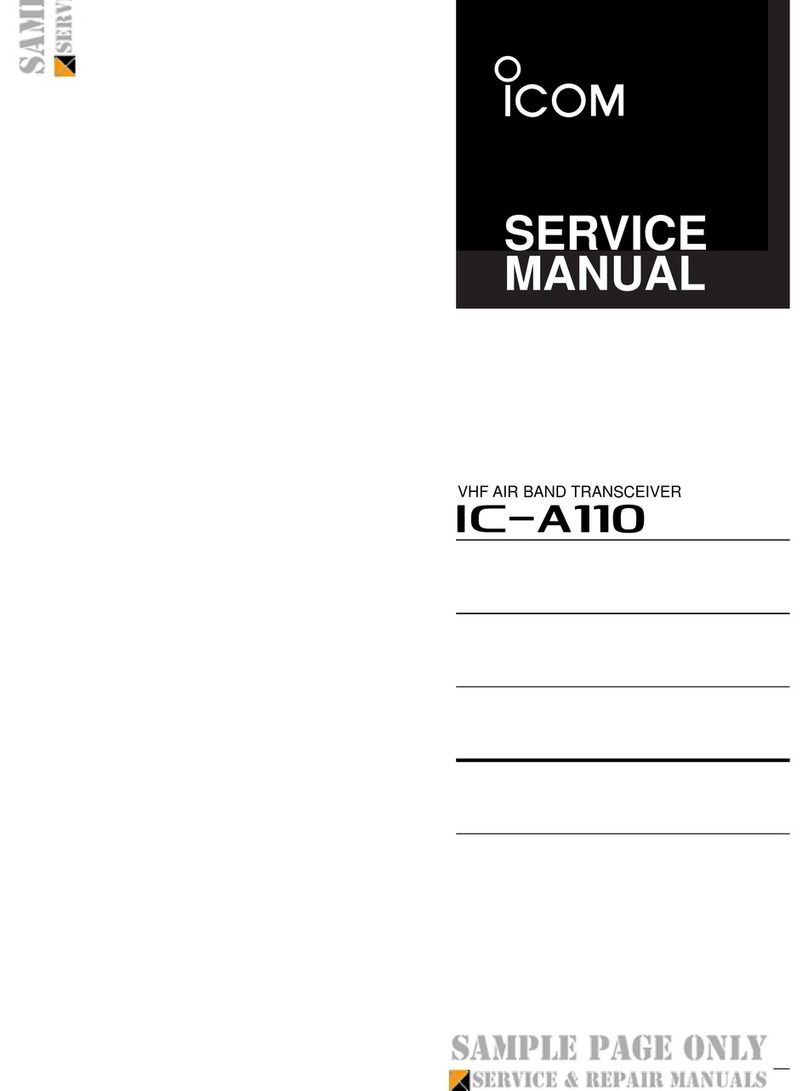
Icom
Icom IC-A110 User manual

Icom
Icom IC-H19S1 User manual
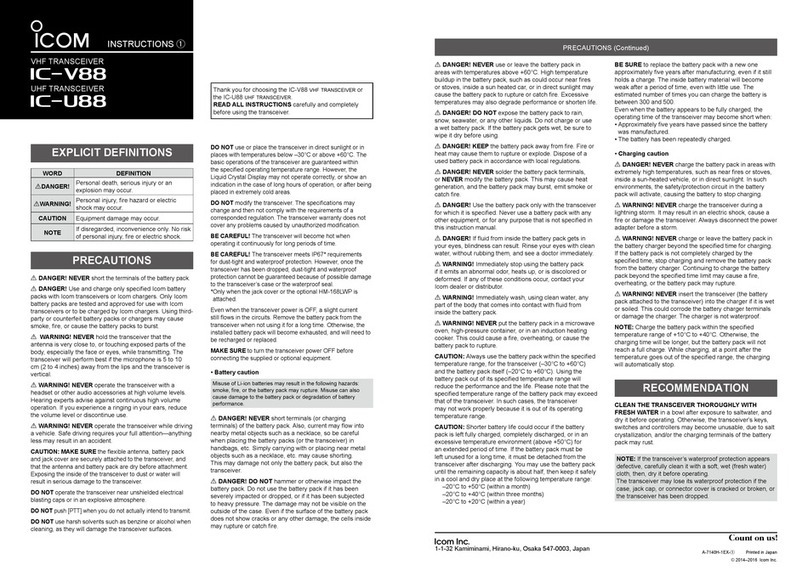
Icom
Icom Ic-V88 User manual

Icom
Icom IC-M88 User manual
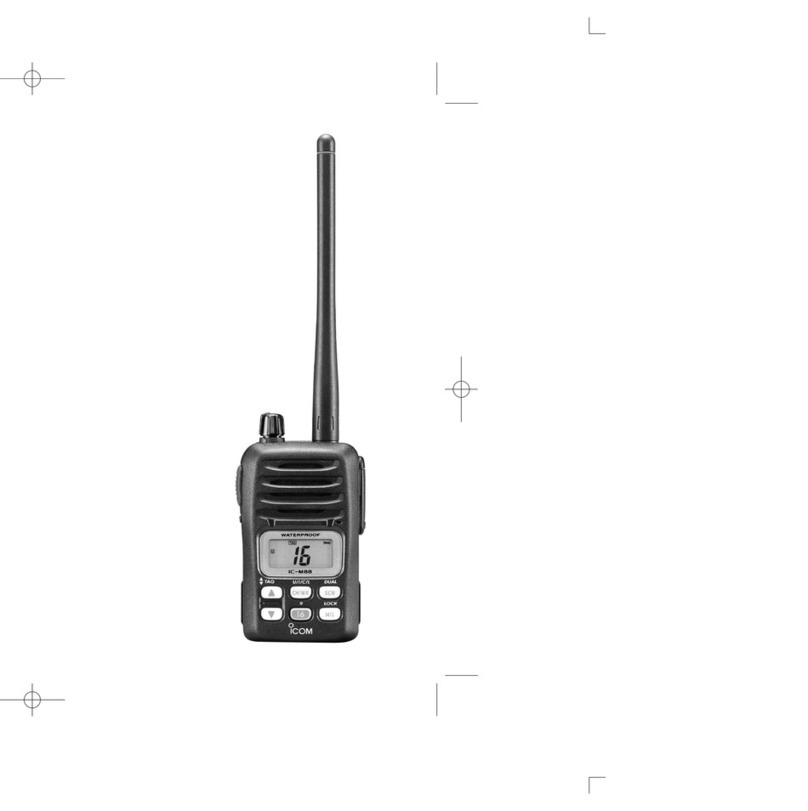
Icom
Icom IC-M88 User manual
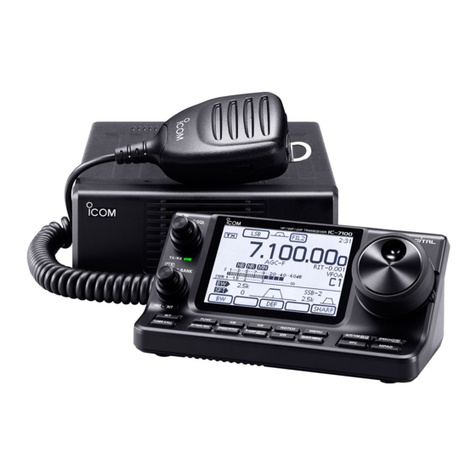
Icom
Icom IC-7100 Installation and operating instructions
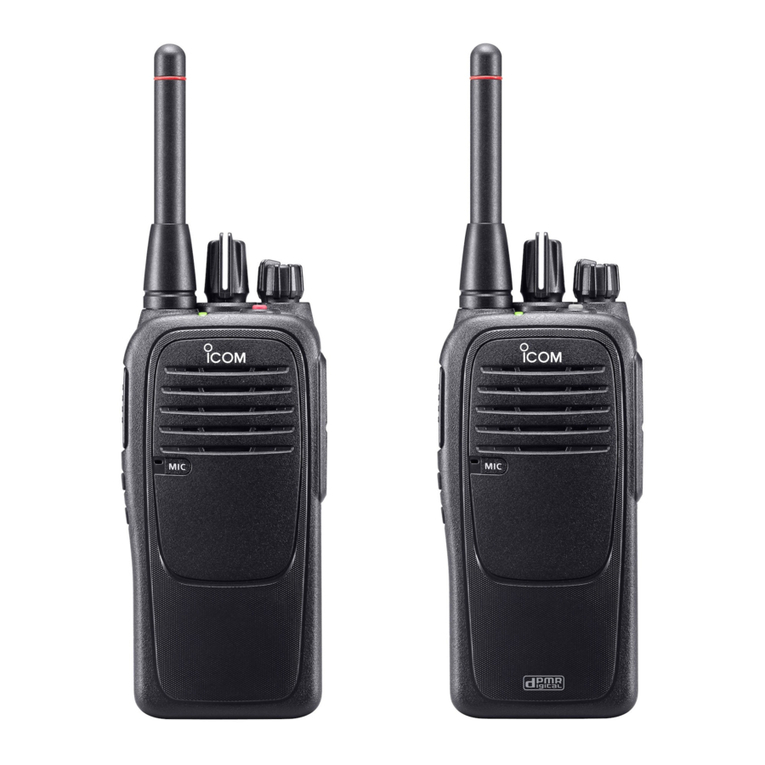
Icom
Icom IC-F29DR2 User manual
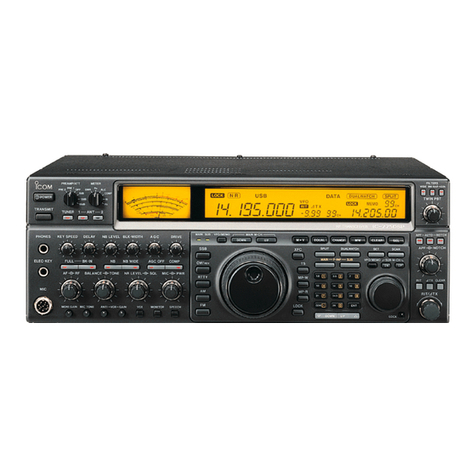
Icom
Icom IC-775DSP User manual
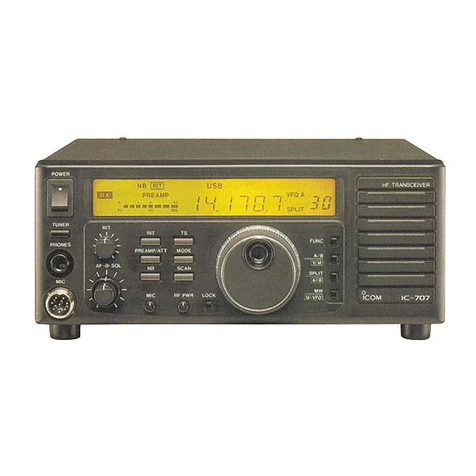
Icom
Icom IC-707 User manual
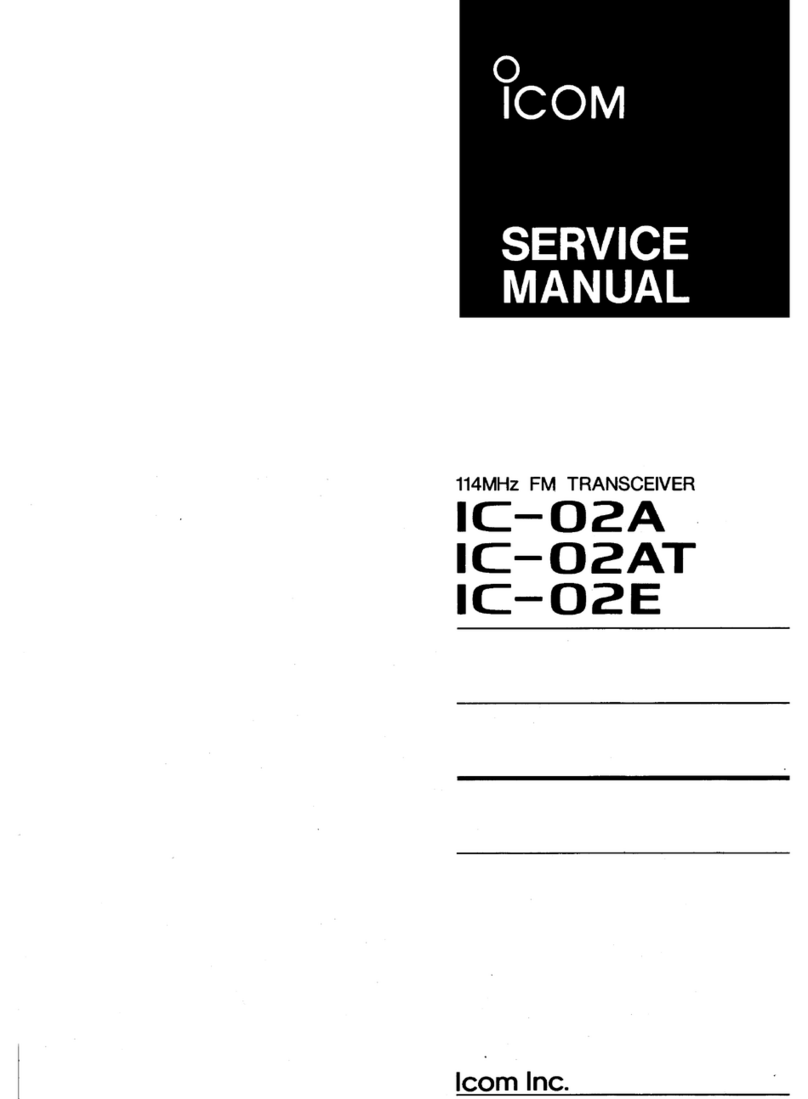
Icom
Icom IC-02A User manual
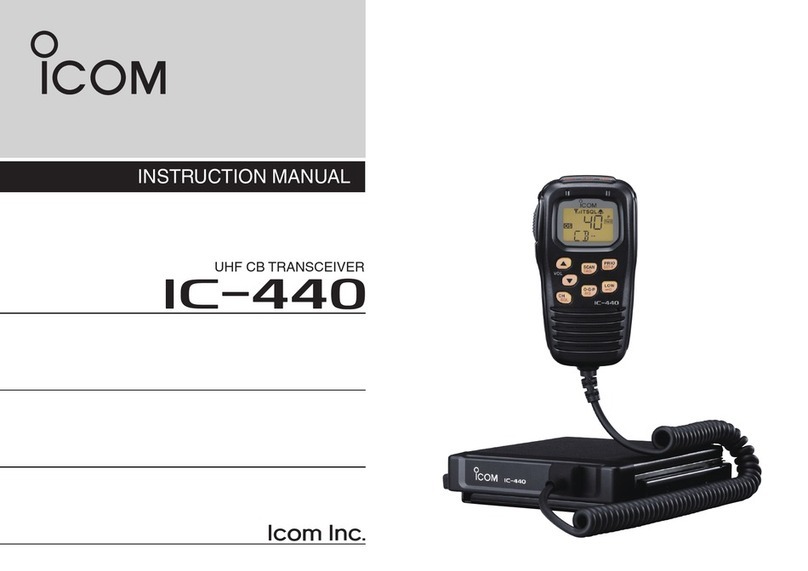
Icom
Icom IC-440 User manual
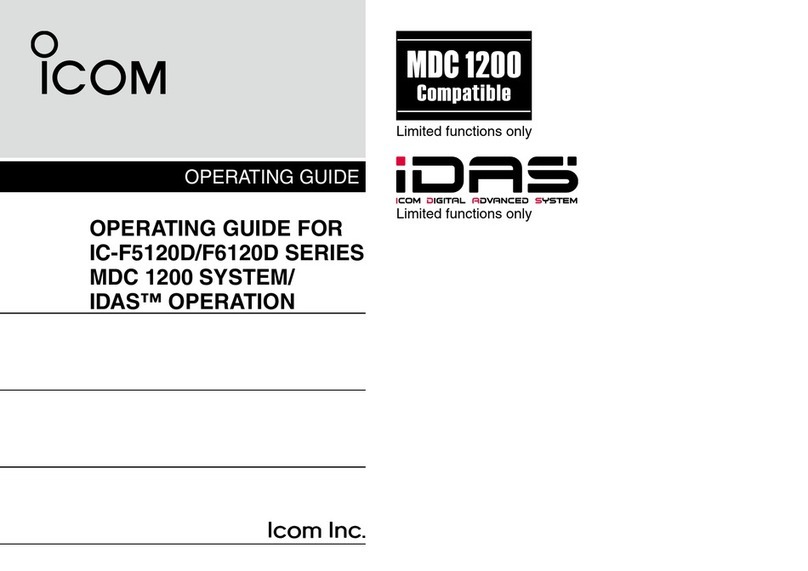
Icom
Icom IC-F5120D Series User manual
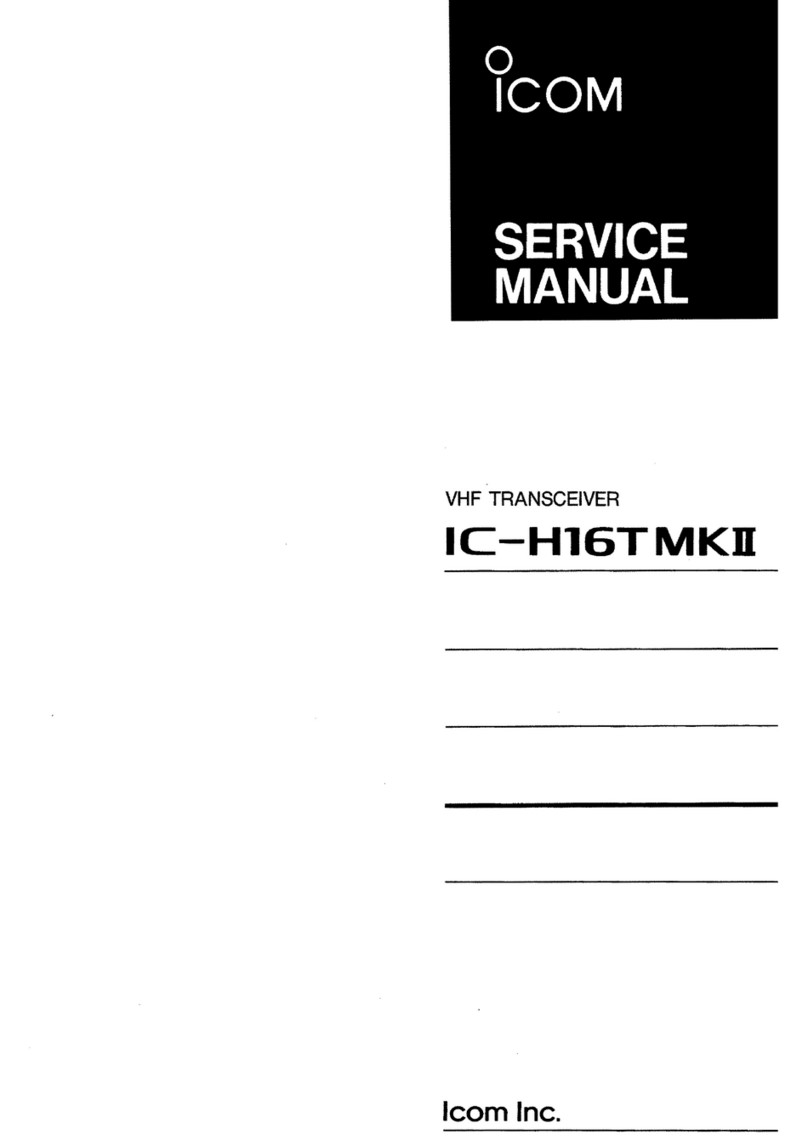
Icom
Icom IC-H16T MKII User manual

